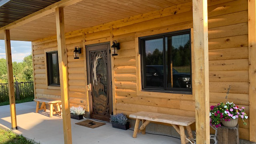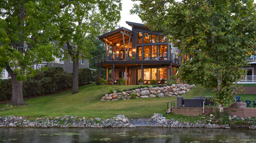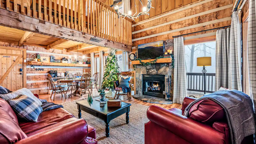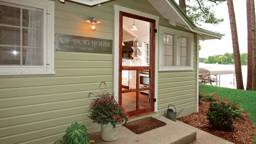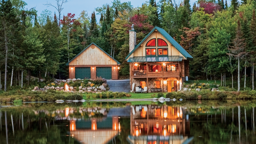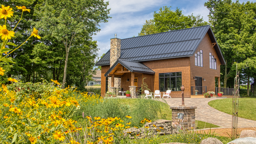A few miles south of the charming harbor town of Grand Marais, Minn., down some twisting dirt roads that lead to a perch overlooking the Cascade River, sits the cabin of award-winning acoustic musician Michael Monroe and his life partner/business agent Deb Mueller. From first glance, it seems like a perfect rustic getaway, but it’s more than that.
The 1,584-square-foot, handcrafted log home and its setting speak of hunting and fishing and of the beauty and glory of living off the land. So it takes a moment to adjust when you walk into the living room and find a wall lined with beautiful handmade guitars, their strings gleaming in the soft LED stage lighting. Turns out you’ve arrived at a Log Cabin Concert.
A truly intimate evening
Much is made of small acoustic musical performances where you’re able to get up close and personal with
the artist – close enough to see their fingers flit across the strings. These concerts are often referred to as “intimate,” and that’s a quality that is coveted when you know you could otherwise be bumping elbows with thousands of other fans in a music venue with suspect acoustics and sight lines.
But, once you’ve sat on a stool in the artist’s bedroom for a good vantage point of the concert he’s giving in the corner of his living room, you get a whole new perspective on the term, “intimate.”
Michael is in his fourth decade of performing nationally, but the log cabin concerts are relatively new. “We’ve been having concerts here for the past eight years,” says Deb proudly. “Last year, we had more than 800 people come to the concerts.” When you consider the performance venue is a living room, and there’s only a handful of concerts each year, that’s quite a feat. And while Michael’s music is a big draw, there’s definitely something to be said for that venue.
Make yourself at home
A few months ago, I had the good fortune to experience a Log Cabin Concert firsthand.
The guests enter through the bottom level, because it’s raining and that’s what the emailed invitation told us to do. There’s a place to hang your coat and store your shoes – actually, places for a few dozen to do so. Clearly, this log cabin is used to having guests. “It’s the suburban part of the house,” Deb says, wrinkling her nose. It’s not faux-modesty, either; you can tell Deb and Michael have their sights set on a basement renovation in the near future. But, in an effort to be a good guest, I just nod in agreement.
The home’s upstairs bathroom is much improved from the state it was in when they found it. “The previous owners had a passion for purple that we just didn’t share,” says Deb. “It was all over the sink and vanity, there was even a claw foot tub with purple feet.” So, soon after they moved in they called in a favor from friend and ceramic artist/tile designer Sharon Moen, who created the handcrafted vanity and mirror that now holds pride of place in their remodeled bathroom space. Opposite the sink is an expansive jet tub so inviting it’s hard to stop yourself from shutting the door, turning on the water, and soaking up the good life on such abundant display in this corner of Northeastern Minnesota. “Sometimes we find people in here after the shows,” Deb says, gesturing at the bathroom. “They’re just hanging out in the bathroom drinking wine.”
Perched above the main living space is a cozy bedroom loft, crisscrossed throughout with the rough-hewn, rich timbers of this log cabin. A floor-to-ceiling wall of doors and windows draws your eye across the bedroom. Noting the lack of any type of drapery, you can’t help but wonder if the morning sun is all the alarm clock they need.
The living room is the cabin’s centerpiece, with its high ceilings and gorgeous wood walls, floors and – well, everything. It flows openly into the gourmet kitchen, and if you look closely you’ll see the staircase, kitchen table and countertops are all made from one white pine tree harvested from the Gunflint Trail area.
“We loved the way the cabin looked from outside,” says Michael, “and then as soon as we walked inside, Deb said, ‘You could play shows in here.’ ”
The anti-Madison Square Garden
Turns out Michael and Deb’s log cabin is the perfect place for an evening of live music built around the joys of nature, solitude and getting away from the big city. And it’s because the cabin is a home first and a concert hall a distant second.
By the time he’s played two guitars and a flute while harmonizing with himself all in the course of a single song, you can’t help but laugh at how ridiculously fortunate you are to have the opportunity to listen to someone with this much talent at a concert in his living room. And yet, you also can’t help but be moved that this is the concert he wants to give. To invite perfect strangers into his home for a concert, strangers like me who might sneak into his bathroom with a glass of wine and look longingly at that tub.
He knows his music is about more than notes and chords. It’s about a lifestyle. An edict. A way to live.
It’s about a call to all to live a simple life.

The music man
Michael Monroe has been writing, recording and performing music for decades. Since his first demo recording 35-plus years ago in the famed “chicken coop” recording studio owned by Noel Paul Stookey of Peter, Paul and Mary, he has recorded 11 albums and toured all over the country. His unique creation of music blends rich vocals, guitar, bamboo and glass flutes, plus a layering and looping technique using digital technology live on stage that he calls “music recycling.”
Michael has also collaborated with National Geographic photographer and best-selling author Jim Brandenburg to produce award-winning TV documentaries and a live theater experience featuring Brandenburg’s images and Michael’s instrumental music.
Today, he writes and records his music from his solar-powered studio on the North Shore of Lake Superior.
Solar sounds
Michael Monroe records all of his music at MisTree Studios in Grand Marais, Minn. Actually – to be more specific – in his backyard. Just off to the side of the log cabin sits a large garage; its top level has been converted to a cozy 400-square-foot, high-tech recording studio run completely by solar power.
This is actually the second home of MisTree Studios. Michael built his first solar studio at their first cabin, a very off-the-grid place in Hovland, Minn. The property had no utilities, but Michael was able to secure recycled solar panels from an electrical company in the area that had just updated their equipment.
“I put them on the roof and bought the batteries and inverters and plugged them in and they worked,” he says, grinning. “It was 1996 when I first got it up and running, and ever since I’ve been using solar power to record.”

Gunflint guitars
One of the first things you notice when you arrive at a Michael Monroe Log Cabin Concert are the guitars lining one wall of the living room. They are – quite frankly – not what a guitar is “supposed” to look like. Asymmetrical, with the sound holes in the top corner or side of the guitar instead of dead center beneath the strings, they’re made of natural materials from Lake Superior’s North Shore. One guitar features a fretboard made from reclaimed birch from the bottom of Lake Superior. Another was made with deer antlers as tuning knobs. They have names like “Flamenca del Rosa.” and “Snow Leopard.” And all of them are the work of David Seaton, a Boundary Waters Canoe Area Wilderness outfitter and trail guide turned guitar maker.
At one point in the evening, Michael spends a few extra minutes tuning and strumming one of his guitars. After a long moment, the notes ring out in the log cabin, and he smiles.
“I could just do that all evening,” he says. “Guitar heaven.”

Where art and nature converge
It’s no wonder Michael Monroe finds inspiration for his music from his surroundings. The cabin that he shares with Deb Mueller is located at a special place where art and nature converge – near the artist’s colony of Grand Marais, Minn., and the wilderness-lover’s paradise known as the Gunflint Trail.
Grand Marais is a remote and picturesque harbor village on Lake Superior. The town of 1,351 people has become a refuge for artists seeking to study in the wilderness. There is a formal Grand Marais Art Colony, which began in 1947 and claims to be the longest-lived art colony in Minnesota. The organization hosts an arts festival and an art competition every summer.
And Grand Marais is home to the nationally renowned North House Folk School, which has a mission of teaching many traditional northern crafts including boatbuilding, sailing, blacksmithing, furniture craft and timber-framing.
The Gunflint Trail is located in Minnesota’s Arrowhead Region in the far northeastern part of the state, just south of the Canadian border and adjoining the eastern part of the Boundary Waters Canoe Area Wilderness (BWCAW). The “trail” is actually a paved two-lane road that starts in Grand Marais and winds north and west for 57 miles along the Laurentian Highlands to Saganaga Lake at the Canadian border.
This area is a naturalist’s and outdoorsman’s delight, prime country for birdwatching, wildlife sightings and canoe trips or Nordic ski adventures through the wilderness. This is where people come to relax, enjoy the sounds of nature, watch a child catch his/her first fish, listen to a loon, or sit by a campfire.
When was the trail built? According to the Gunflint Trail Historical Society, “The original path that has today become the Gunflint Trail was originally an overland footpath used to travel from the inland lakes to the shore of Lake Superior. No one knows precisely when the footpath was established, but we can guess that it was hundreds of years ago, and it was first used by the native Sioux, then Ojibwe who have called this area home for hundreds of years.”
Andy Bennett, a longtime contributor to Cabin Life, is a native of northern Minnesota who knows his way up and down the North Shore of Lake Superior.







